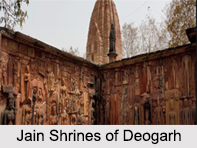![]() Popularly known as the Temple Town, Deogarh is nestled by the banks of the Betwa River in the Lalitpur district of Uttar Pradesh. Deogarh is of great epigraphy and archaeological importance, its name has appeared chronologically throughout history during the reign of the Guptas, the Gujjars, the Pratiharas, the Muslim rulers of Delhi, and Kalpi, the Marathas and the British. The village of Deogarh attracts thousands of tourists who visit the place to get a glimpse of history and traverse through the archaeological sites and museums. Discussed elaborately below are few of the most important places of interest in Deogarh.
Popularly known as the Temple Town, Deogarh is nestled by the banks of the Betwa River in the Lalitpur district of Uttar Pradesh. Deogarh is of great epigraphy and archaeological importance, its name has appeared chronologically throughout history during the reign of the Guptas, the Gujjars, the Pratiharas, the Muslim rulers of Delhi, and Kalpi, the Marathas and the British. The village of Deogarh attracts thousands of tourists who visit the place to get a glimpse of history and traverse through the archaeological sites and museums. Discussed elaborately below are few of the most important places of interest in Deogarh.
Dashavatara Temple: One of the earliest known Panchyatan temples in North India, which means where the main shrine is surrounded by 4 subsidiary shrines. The Dashavatara Temple is dedicated to Lord Vishnu and is a fine example of the Gupta architecture. The temple depicts the 10 incarnations of Lord Vishnu and showcases some interesting features, such as the carvings of the river goddesses Ganga and Yamuna on the doorway leading to the sanctum sanctorum. There are also carved panels of Vaishnava mythology elated to Gajendra Moksha, the Nara Narayana Tapasya and the Sheshashayi Vishnu, which is the reclining on the serpent posture, are portrayed. The temple is noted for being the first North Indian temple with a spire or shikhara. Erotic panels are also an added attraction here.
 Deogarh Fort: Partially named after the Chandela ruler Kiritivarman, the Deogarh Fort was built in 1057 and is also known as the Kirtigiridurga Fort. However, it has been theorized that the fort was built earlier by the Pratihara rulers of Kannauj in the 9th century, changed hands from the builders to the Chandelas and the Bundelas, before it came under the control of the Scindias of Gwalior. There are 3 major ghats – Nahar Ghat, Rajghat and the Ghat with the Saint"s Cave; these ghats have archaeological significance and provide approach to the Betwa River. The cliffs above the 3 ghats are embellished with Gupta sculptures and inscriptions dating from various periods.
Deogarh Fort: Partially named after the Chandela ruler Kiritivarman, the Deogarh Fort was built in 1057 and is also known as the Kirtigiridurga Fort. However, it has been theorized that the fort was built earlier by the Pratihara rulers of Kannauj in the 9th century, changed hands from the builders to the Chandelas and the Bundelas, before it came under the control of the Scindias of Gwalior. There are 3 major ghats – Nahar Ghat, Rajghat and the Ghat with the Saint"s Cave; these ghats have archaeological significance and provide approach to the Betwa River. The cliffs above the 3 ghats are embellished with Gupta sculptures and inscriptions dating from various periods.
Jain Shrines: Apart from the Dashavatara Temple, Deograh is also a famous Jain Centre in India. It boasts of as many as 31 remarkable ancient Jain temples. It has been said that Deogarh has been a Jain centre since the post-Gupta period until the end of the 17th century. These Jain complexes were built sometime between the 8th to the 17th century and houses around 2,000 sculptures which happens to be one of the largest collections in the world. The panels inside these Jain temples depict panoramas of Jain mythology, images of the Tirthankaras, a Manastambha -votive pillars and Ayagpatta- votive tablets, carved on the walls of the temple. These temples are situated on the eastern part of the Deogarh Fort.
Deogarh Archaeological Museum: The area of Deogarh is of great archaeological significance and over time several excavations have been carried out here. The Deogarh Archaeological Museum houses relics, artefacts and other objects of interest found in this region. These displays and exhibits bring to life the times of the Gupta period and throw light on the evolution of Jainism. The museum attracts historians and researchers who wish to study more about the monuments found in Deogarh and the displays found within the museum.
Other places of interest in Deogarh are the natural cave of Muchkund, the towns of Chanderi, which is well known for their gossamer Chanderi sarees, and Barua Sagar.
Visiting Information on Deogarh
The nearest airport to Deogarh is the Gwalior Airport, which is at a distance of 235 km. The primary railhead from Deogarh is the Lalitpur railway station at a distance of 23 km while the nearest railway station to the village is Jakhlaun at a distance of 13 km. There is also availability of other means of transportations like buses which are connected to all the important centres in the region.



















